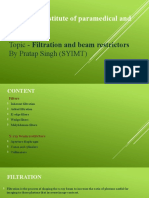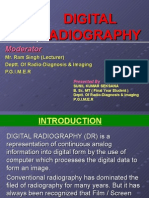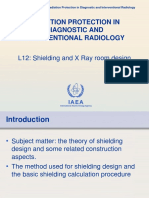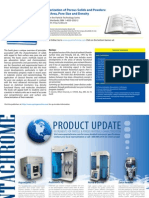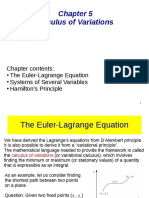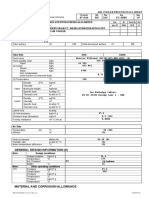100%(1)100% found this document useful (1 vote)
86 viewsRadiographic Exposure
Radiographic Exposure
Uploaded by
chowhkThis document discusses factors that influence radiographic exposure and image quality. It describes how exposure factors like kVp, mA, time and mAs determine the quantity and quality of radiation during an x-ray as well as influence noise and contrast. Additional factors like focal spot size, filtration and generator type are described. Image quality depends on spatial resolution, contrast resolution and reducing noise, and is influenced by film and subject characteristics as well as exposure settings.
Copyright:
© All Rights Reserved
Available Formats
Download as PDF, TXT or read online from Scribd
Radiographic Exposure
Radiographic Exposure
Uploaded by
chowhk100%(1)100% found this document useful (1 vote)
86 views70 pagesThis document discusses factors that influence radiographic exposure and image quality. It describes how exposure factors like kVp, mA, time and mAs determine the quantity and quality of radiation during an x-ray as well as influence noise and contrast. Additional factors like focal spot size, filtration and generator type are described. Image quality depends on spatial resolution, contrast resolution and reducing noise, and is influenced by film and subject characteristics as well as exposure settings.
Original Description:
radiographicexposureandimagequality-100510232126-phpapp02.pdf
Original Title
radiographicexposureandimagequality-100510232126-phpapp02
Copyright
© © All Rights Reserved
Available Formats
PDF, TXT or read online from Scribd
Share this document
Did you find this document useful?
Is this content inappropriate?
This document discusses factors that influence radiographic exposure and image quality. It describes how exposure factors like kVp, mA, time and mAs determine the quantity and quality of radiation during an x-ray as well as influence noise and contrast. Additional factors like focal spot size, filtration and generator type are described. Image quality depends on spatial resolution, contrast resolution and reducing noise, and is influenced by film and subject characteristics as well as exposure settings.
Copyright:
© All Rights Reserved
Available Formats
Download as PDF, TXT or read online from Scribd
Download as pdf or txt
100%(1)100% found this document useful (1 vote)
86 views70 pagesRadiographic Exposure
Radiographic Exposure
Uploaded by
chowhkThis document discusses factors that influence radiographic exposure and image quality. It describes how exposure factors like kVp, mA, time and mAs determine the quantity and quality of radiation during an x-ray as well as influence noise and contrast. Additional factors like focal spot size, filtration and generator type are described. Image quality depends on spatial resolution, contrast resolution and reducing noise, and is influenced by film and subject characteristics as well as exposure settings.
Copyright:
© All Rights Reserved
Available Formats
Download as PDF, TXT or read online from Scribd
Download as pdf or txt
You are on page 1of 70
Radiographic Exposure
Exposure Factors influence and determine
the quantity and quality of the x-radiation
to which the patient is exposed.
Radiation quantity refers to the radiation
intensity referred to as mR or mR/ mAs.
Radiation Quality refers to the beam
penetrability and measured in HVL.
Radiographic Exposure
The radiographic exposure factors are
under the control of the operator except for
those fixed by the design of the x-ray
machine.
There are two choices for focal spot.
With the exception of compensating filters,
added filtration is fixed.
The type of high voltage power is also
fixed.
Exposure Factors Controlled by
the Operator
kVp
mA times Exposure Time = mAs
Determines the quality and quantity of the
exposure
SID, Focal Spot and Filtration are
secondary factors
kVp
As we have discussed in the laboratory,
kVp controls radiographic contrast.
kVp determines the ability for the beam to
penetrate the tissue.
kVp has more effect than any other factor
on image receptor exposure because it
affects beam quality.
kVp
To a lesser extent it also influences the
beam quantity.
As we increase kVp, more of the beam
penetrates the tissue with higher energy
so they interact more by the Compton
effect.
This produces more scatter radiation
which increases image noise and reduces
contrast.
kVp
50 kV 79% is photoelectric, 21% Compton, < 1%
no interaction
80 kVp 46% is photoelectric, 52% Compton 2%
no interaction
110 kVp 23% photoelectric, 70% Compton, 7%
no interaction
As no interaction increases, less exposure is
needed to produce the image so patient
exposure is decreased.
mA
1 Ampere = 1 C/s = 6.3 x 10
18
electrons/ second.
The mA selected for the exposure determines
the number of x-rays produced.
The number of x-rays are directly proportional to
the mA assuming a fixed exposure time.
100 mA produced half the x-ray that 200 mA
would produce.
mA
Patient dose is also directly proportional to
the mA with a fixed exposure time.
A change in mA does not affect kinetic
energy of the electrons therefore only the
quantity is changed.
mA
Many x-ray machines are identified by the
maximum mA or mAs available.
A MP 500 has a maximum mAs of 500
mAs.
A Universal 325 has a maximum mA of
300 and maximum kVp of 125
mA
More expensive three phase machines will
have a higher maximum mA.
A General Electric MST 1050 would have
1000 mA and 150 kVp.
Exposure Time
The exposure time is generally always
kept as short as possible.
This is not to reduce patient exposure but
to minimize motion blur resulting from
patient movement.
This is a much greater problem with
weight bearing radiography.
Exposure Time
Older machine express time as a fraction.
Newer machines express exposure time
as milliseconds (ms)
It is easy to identify the type of high
voltage generation by looking at the
shortest exposure time.
Exposure Time
Single phase half wave rectified fasted
exposure time is 1/60 second 17 ms.
Single phase full wave rectified fastest
exposure time is 1/120 second or 8 ms
Three phase and high frequency can
provide exposure time down to 1 ms.
mAs
mA and exposure time is usually
combined and used as one factor
expressed as mAs.
mAs controls radiation quantity, optical
density and patient dose.
mAs determine the number of x-rays in the
beam and therefore radiation quantity.
mAs does not influence radiation quality.
mAs
Any combination of mA and time that will
give the same mAs should provide the
same optical density on the film. This is
referred to as the reciprocity law.
As noted earlier for screen film
radiography, 1 ms exposure and exposure
longer than 1 seconds do not follow this
rule.
mAs
On many modern machines, only mAs can
be selected. The machine automatically
gives the operator the highest mA and
shortest exposure time.
The operator may be able to select mA by
what is referred to as Power level.
mAs
mAs is one way to measure electrostatic
charge. It determines the total number of
electrons.
Only the quantity of the photons are
affected by changes in the mAs.
Patient dose is therefore a function of
mAs.
mAs
If we know the mR/mAs, multiply that
figure times the mAs. or
If we know the mR for a given exposure at
a given kVp, we can divide the exposure
by the mAs to get the mR/ mAs.
To compute exposure we need to know
what the mR/mAs is for the kVp used and
the SID.
Distance
Distance affects the exposure of the
image receptor according to the inverse
square law.
Distance affects the intensity of the x-ray
beam at the film but has no effect on
radiation quality.
Inverse Square Law
mAs (second exposure) SID
2
2nd
exposure
----------------------------= -------------------------
mAs (first exposure) SID
2
1st exposure
Distance
The most common source to image
distances are 40 (100 cm) and 72(182
cm)
Since SID does not impact the quality of
the beam, adjustments to the technical
factors are made with the mAs.
To go from 40 to 72 increase the mAs
3.5 time.
Distance
Increasing the distance will impact the
geometric properties of the beam.
Increased SID reduces magnification
distortion and focal spot blur.
With the need to increase the mAs 3.5
times for the 72 SID, tube loading
becomes a concern.
Distance
72 SID is used for Chest radiography and
the lateral cervical spine to reduce
magnification.
72 SID used for the full spine to get a 36
beam.
Imaging System Characteristics
Operator has limited control.
The following will impact the technical
factors based upon the type of machine.
Focal Spot Size
Filtration
High-voltage Generation
Focal Spot Size
Most machines limited to two focal spot
sizes.
Common office focal spots are 1.0 mm for
the small and 2.0 mm for large.
Highly detailed radiography such as
mammography use micro-focus tubes with
0.1 mm and 0.3 mm focal spot sizes.
Focal Spot Size
The focal spot size limits the tubes
capacity to produce x-rays. The electrons
and resulting heat are placed on a smaller
portion of the x-ray tube.
The mA is therefore limited for the small
focal spot. This results in longer exposure
times with greater chance of patient
movement.
Focal Spot Size
For single phase machines, the small focal
spot use is limited to extremities and the
cervical spine.
With high frequency, most views can be
done on the small focal spot except for
larger patient and ones that cannot hold
still.
My limit is exposure times less than 1/2 s.
Focal Spot Size
If the mA is properly calibrated, the focal
spot will have no impact on the quantity or
quality of the beam.
Filtration
All x-ray beams are affected by the
filtration of the tube. The tube housing
provides about 0.5 mm of filtration.
Additional filtration is added in the
collimator to meet the 2.5 mm of aluminum
minimum filtration required by law.
2.5 mm is required for 70 kVp.
Filtration
3.0 mm is required for at 100 kVp.
3.2 mm is required for operations at 120
kVp.
Most machines now are capable of over
100 kVp operation.
We have no control on these filters.
Filtration
Chiropractic radiography is a leader in the
use of compensating filters. We have total
control over compensating filtration.
In areas of the body with high subject
contrast or wide differences in density,
compensating films improve image quality
and reduce patient exposure.
High-voltage Generation
You will determine the type of high-voltage
generation when you purchase your x-ray
machine.
The type of generator will determine the
efficiency of the generator or the amount
of ripple in the wave form.
Single phase has 100% ripple.
Three Phase Generation
Three phase has a 14% so it is significant
improvement in efficiency increasing both
quality and quantity of the beam.
More x-rays per mAs with higher energy.
Cost to provide 3 phase power is very high
so not practical in office.
High Frequency Generation
Virtually no ripple ( less than 1%.)
Inexpensive and can use normal incoming
power.
Provides significant reduction is mAs or
kVp compared to single phase. Reduction
of mAs by 50% compared to single phase
techniques.
Chapter 19 Radiographic
Quality
Radiographic Quality refers to the fidelity
with which the anatomic structures being
examined are images on the film.
Three main factors:
Film Factors
Geometric Factors
Subject Factors
Radiographic Quality
Characteristic of radiographic quality:
Spatial Resolution (Recorded Detail)
Contrast Resolution (Visibility of Detail)
Noise (Visibility of Detail)
Artifacts
Spatial Resolution
Spatial Resolution is the ability to image
small structures that have high subject
contrast such as bone-soft tissue
interface.
When all of the factors are correct,
conventional radiography has excellent
spatial resolution.
Contrast Resolution
Contrast resolution is the ability to
distinguish structures with similar subject
contrast such as liver-spleen, fat-muscle.
Computed tomography and MRI have
excellent contrast resolution. Convention
radiology is fair to poor.
Noise
Noise is an undesirable fluctuation in
optical density of the image. Two major
types:
Film Graininess- no control over
Quantum Mottle- some control over
Film Graininess
Film graininess refers to the distribution in
size and space of the silver halide grains
in the film emulsion.
Similar to photographic film. 400 ASA film
is more graininess than 100 ASA film.
Similar to structure mottle that refers to
the size and shape of the phosphors in the
intensifying screens.
Quantum Mottle
Quantum mottle refers to the random
nature of how the x-rays interact with the
image receptor.
It is the primary form of radiographic noise.
The use of high mAs and low kVp reduced
quantum mottle.
Quantum Mottle
Very fast screens have higher quantum
mottle because it takes fewer x-rays to
make the image.
Speed
Resolution and noise are intimately
connected with speed.
While the speed of the images receptor is
not apparent on the image, it influences
both resolution and noise.
Radiographic Quality Rules
Fast Image receptors have high noise and
low spatial and contrast resolution.
High spatial and contrast resolution
require low noise and slow image
receptors.
Low noise accompanies slow image
receptors with high spatial and contrast
resolution.
Film Factors of Quality
Characteristic curve
Density
Contrast
Latitude
Processing
Time
Temperature
Sensitometry
Sensitometry is the study of the
relationship between the intensity of
exposure of the film and the blackness
after the film is processed.
Unexposed film is clear with a blue tint
after processing.
Exposed film is black after processing.
Sensitometry
Two principles involved.
Exposure of the film
Amount of light transmitted through the
processed film of optical density.
Used to describe the relationship of
radiation exposure and blackness or
density on the film.
Characteristic Curve
This relationship is
called the
characteristic curve or
H & D curve of the
film.
H & D stands for
Hurter and Driffield.
Parts of the Characteristic
Curve
Toe and shoulder
where large changes
in exposure results in
small changes in OD.
Very high and very
low variations of
exposure make very
small changes in
density.
Parts of the Characteristic
Curve
The straight line or
intermediate area is
where very small
changes in exposure
results in large
changes in density.
This is the important
part of the curve in
radiography.
Log Relative Exposure (LRE)
X-ray films responds
to a wide range of
exposure from 1 mR
to 1000 mR.
Exposure is
represented on
logarithmic manner.
Optical Density Range
The optical density
range is from 0.0 for
no density to 4.0 for
absolute black.
Useful range in
general radiography
is from 0.5 to 2.25.
Image range is 0.5 to
1.25 OD
Base fog or base density
The tint of the base of
the film and the
inadvertent exposure
of the during
processing.
Range is from 0.1 to
0.3. Should be never
above 0.30 most is
.21 OD
Items that Impact Base Fog
Film storage
Film exposure to wrong spectrum of light
or light intensity.
Chemical contamination.
Improper processing.
High Base fog levels reduce contrast.
Contrast
Radiographic Contrast is the combined
result of image receptor contrast and
subject contrast.
Image receptor contrast refers to the
contrast inherent in the film and influenced
by the processing of the film.
Contrast
Subject contrast is determined by the size,
shape and x-ray attenuating
characteristics of the subject being
examined and the energy (kVp) of the x-
ray beam.
Image Receptor Contrast
Inherent to the film and screen
combination but is influenced by:
Range of Optical Density
Film Processing Technique
Film type is determined by the type of
intensifying screens used but many
dealers sell off brands of film.
Image Receptor Contrast
The slope of the
straight line portion of
the H & D curve is the
receptor contrast.
The average gradient
is a straight line
drawn between the
densities of 0.25 and
2.00 + base fog.
Average Gradient
The average gradient
is a straight line
drawn between 0.25
OD and 2.0 OD
above base plus fog.
This is the normal
range of density in a
radiograph
Speed
Speed is the ability of
the receptor to
respond to low x-ray
exposure.
The H & D curse is
useful in comparing
speed when selecting
film or screens.
Speed
A relative number of 100 given to Par
Speed Calcium Tungstate Screens.
High Speed Calcium Tungstate has a
speed of 200. Half of the exposure is
needed to produce the same image.
Rare earth screen film combinations range
is speed from 80 to 1600.
Speed
By knowing the Speed, sometimes
referred to as the Relative Speed Value, it
is easy to convert the technical factors for
one speed to another speed.
LATITUDE
Latitude can be
observed on the H &
D curve.
Latitude refers to the
range of exposure
that will produce a
diagnostic range OD.
Latitude
Latitude and Contrast
are inversely
proportional.
Wide latitude has a
wide gray scale or low
contrast. (B)
Narrow latitude has a
short scale or high
contrast. (A)
Latitude
Latitude is designed into some screen and
film combinations. With wide latitude, the
error factor in technique is wider.
Latitude can also be impacted by the
technical factors.
Film Processing
Radiographic Quality
is impacted by film
processing
parameters.
The developer must
be at the proper
concentration and at
the correct
temperature.
Film Processing
The film must also
spend the correct
amount of time in the
developer.
This is the time &
temperature
relationship.
Processing
Speed and base fog increase with the
temperature.
Contrast will increase to a point and then
drop with the base fog increase.
Manufactures set processing parameters
to optimize speed, contrast and low base
fog.
Processing
In 9th Quarter we will discuss processor
quality control in detail.
End of Lecture
Return to Lecture Index
Return to Physics Homepage
You might also like
- RPDIR-P12.1 Shielding Calculation WEBDocument23 pagesRPDIR-P12.1 Shielding Calculation WEBPici-pici BaliNo ratings yet
- Ayaw Sigig Cellphone Oy! Priorities First! PRAY Lang!Document6 pagesAyaw Sigig Cellphone Oy! Priorities First! PRAY Lang!Kenneth Mae Padual GullanNo ratings yet
- Production of Propylene GlycolDocument31 pagesProduction of Propylene GlycolHikaru Moka67% (3)
- Factors Influencing The X-Ray BeamDocument17 pagesFactors Influencing The X-Ray BeambontleNo ratings yet
- Grids and Scatter ReductionDocument79 pagesGrids and Scatter ReductionMondiaal Financial ServicesNo ratings yet
- Radiograpic Quality and Technique EvaluationDocument44 pagesRadiograpic Quality and Technique EvaluationZahra Jamilah SabrinaNo ratings yet
- Unit V Radiographic TestingDocument30 pagesUnit V Radiographic TestingMohamed ElfawalNo ratings yet
- The X-Ray Film and Other Image ReceptorsDocument29 pagesThe X-Ray Film and Other Image ReceptorsbontleNo ratings yet
- Challenge Questions 1. Define or Otherwise Identify The Following: A. SolventDocument10 pagesChallenge Questions 1. Define or Otherwise Identify The Following: A. SolventAlvi SantosNo ratings yet
- General Radio Graphic Image QualityDocument9 pagesGeneral Radio Graphic Image QualityRouben ParmanumNo ratings yet
- Scatter RadiationDocument10 pagesScatter RadiationDurgarao VasaNo ratings yet
- Radtechnique Report1Document22 pagesRadtechnique Report1Dana Nathalie CodillaNo ratings yet
- Notebook 2Document4 pagesNotebook 2api-335583967No ratings yet
- X-Ray Film, Intensifying Screens and Grids PDocument37 pagesX-Ray Film, Intensifying Screens and Grids PprasadNo ratings yet
- Film Faults and Factors Affecting The Radiographic ImageDocument28 pagesFilm Faults and Factors Affecting The Radiographic Imagebathinsreenivas100% (1)
- RT09 PDFDocument33 pagesRT09 PDFPradeep Kumar Bowmaraju100% (1)
- X - Ray Film: by Sahil Gupta Assistant Professor RIMT UniversityDocument37 pagesX - Ray Film: by Sahil Gupta Assistant Professor RIMT UniversityZainNo ratings yet
- ARTIFACTSDocument32 pagesARTIFACTSShan Angelie Sarmiento100% (1)
- Xray PropertiesDocument32 pagesXray PropertiesJesse Yaw BaafiNo ratings yet
- Unit-5 Radiography: AdvantagesDocument23 pagesUnit-5 Radiography: AdvantagescandypranavNo ratings yet
- Chapter 001Document25 pagesChapter 001nadoosh23No ratings yet
- (Finals) Lecture Image ProductionDocument72 pages(Finals) Lecture Image ProductionGiralph Nikko100% (1)
- The Radiographic ImageDocument18 pagesThe Radiographic ImageMohamed AufNo ratings yet
- RA 110 Radiographic Techniques Packet Test 1Document20 pagesRA 110 Radiographic Techniques Packet Test 1sabba_420No ratings yet
- Filters and Beam Restrictors in RadiologyDocument19 pagesFilters and Beam Restrictors in RadiologyPratap singhNo ratings yet
- Production and Properties of X - Rays: MODULE-20Document105 pagesProduction and Properties of X - Rays: MODULE-20Santosh BhandariNo ratings yet
- Digital Radiography - Sunil SeksanaDocument65 pagesDigital Radiography - Sunil Seksanamanishbabu100% (8)
- Grid & Control of Scatter RadiationDocument173 pagesGrid & Control of Scatter RadiationAliNo ratings yet
- Filters and Beam Restrictors.Document44 pagesFilters and Beam Restrictors.Manali PadsalgikarNo ratings yet
- Notebook 2 - RevisedDocument3 pagesNotebook 2 - Revisedapi-338659956No ratings yet
- Radiation DosimetryDocument18 pagesRadiation DosimetrySmita SharmaNo ratings yet
- Digital Radiography Versus Computed Radiography: Reviewed byDocument6 pagesDigital Radiography Versus Computed Radiography: Reviewed byEl DoNo ratings yet
- Radiology Physics X-Ray ProductionDocument34 pagesRadiology Physics X-Ray ProductionTHESSNAVARRO100% (2)
- Scatter Radiation-Its Origin Is The Compton Scatter, The Incoming (High Energy Photon Uses A Part of ItsDocument6 pagesScatter Radiation-Its Origin Is The Compton Scatter, The Incoming (High Energy Photon Uses A Part of ItsmarrapescaNo ratings yet
- 2 Fundamental Principles of RadiobiologyDocument28 pages2 Fundamental Principles of RadiobiologyAngelo RamosNo ratings yet
- Sensitometry and Characteristic CurveDocument67 pagesSensitometry and Characteristic Curvesarose bhandari100% (2)
- 01-Quantities and Units in Radiation Protection-RSRC-2018-EEIDocument44 pages01-Quantities and Units in Radiation Protection-RSRC-2018-EEIMichael Murillo BaraquioNo ratings yet
- Latent Image FormationDocument46 pagesLatent Image FormationKristina Shrestha100% (1)
- What Is Digital Hospital?Document15 pagesWhat Is Digital Hospital?Muhammad AriffiqrihNo ratings yet
- Chest Xray BasicsDocument47 pagesChest Xray BasicsPartha GanesanNo ratings yet
- Radiography l2 NotesDocument63 pagesRadiography l2 NotesaasattiNo ratings yet
- Radiography Technique - Exposure FactorsDocument36 pagesRadiography Technique - Exposure FactorsYuda FhunkshyangNo ratings yet
- The Photographic Process and Film SensitivityDocument27 pagesThe Photographic Process and Film SensitivityKaushal GandhiNo ratings yet
- Becquerel and Sievert: Becquerel (BQ) Becquerel (BQ) Sievert (SV) Sievert (SV)Document10 pagesBecquerel and Sievert: Becquerel (BQ) Becquerel (BQ) Sievert (SV) Sievert (SV)Ahmed shabanNo ratings yet
- 04 Radiation PenetrationDocument0 pages04 Radiation PenetrationNata AdriyaNo ratings yet
- IAEADocument50 pagesIAEAPaulo BrazNo ratings yet
- X-Ray Production and InteractionsDocument8 pagesX-Ray Production and InteractionsHanan AliNo ratings yet
- Production and Characteristics of X-RaysDocument48 pagesProduction and Characteristics of X-Raysmuli aniNo ratings yet
- Optical Density (Radiographic Density) : T o T o o TDocument6 pagesOptical Density (Radiographic Density) : T o T o o TAaron Raphael Ocampo AbenesNo ratings yet
- (Finals) Lecture Image Production PDFDocument72 pages(Finals) Lecture Image Production PDFGiralph Nikko100% (1)
- Equations For Radiation SafetyDocument1 pageEquations For Radiation SafetyForeman WestermanNo ratings yet
- CASSETTEDocument15 pagesCASSETTENadeem ShahNo ratings yet
- Health PhysDocument7 pagesHealth PhysCarlos BustamanteNo ratings yet
- Radiation Safety of X Ray Generators and Other Radiation Sources Used for Inspection Purposes and for Non-medical Human Imaging: Specific Safety GuideFrom EverandRadiation Safety of X Ray Generators and Other Radiation Sources Used for Inspection Purposes and for Non-medical Human Imaging: Specific Safety GuideNo ratings yet
- Non-ionizing Radiation Protection: Summary of Research and Policy OptionsFrom EverandNon-ionizing Radiation Protection: Summary of Research and Policy OptionsNo ratings yet
- SemifinalsDocument51 pagesSemifinalsmaricar paracadNo ratings yet
- Exposure Factors: DR Hussein Ahmed HassanDocument39 pagesExposure Factors: DR Hussein Ahmed HassanchowhkNo ratings yet
- Unit 3 - Mammography EquipmentDocument74 pagesUnit 3 - Mammography EquipmentHidajeta ĐedovićNo ratings yet
- 7 - Individual Limits For Member of The Public-8Document15 pages7 - Individual Limits For Member of The Public-8Bashar BassamNo ratings yet
- Allardyce To Sue FA Over SackingDocument1 pageAllardyce To Sue FA Over SackingchowhkNo ratings yet
- Graft Is Public Enemy NoDocument2 pagesGraft Is Public Enemy NochowhkNo ratings yet
- 15 Missing After Boat Loses Contact Off SarawakDocument1 page15 Missing After Boat Loses Contact Off SarawakchowhkNo ratings yet
- PM: Economy Still GrowingDocument2 pagesPM: Economy Still GrowingchowhkNo ratings yet
- Malaysians Are Going PlacesDocument1 pageMalaysians Are Going PlaceschowhkNo ratings yet
- Building A SystemDocument24 pagesBuilding A SystemchowhkNo ratings yet
- Is Crayon Shin-Chan The Bad Boy of MangaDocument3 pagesIs Crayon Shin-Chan The Bad Boy of MangachowhkNo ratings yet
- Exposure Factors: DR Hussein Ahmed HassanDocument39 pagesExposure Factors: DR Hussein Ahmed HassanchowhkNo ratings yet
- Highlights On ASME Essential VariablesDocument8 pagesHighlights On ASME Essential VariableschowhkNo ratings yet
- Key Criteria For Matching Filler Metals To Your Base MaterialDocument3 pagesKey Criteria For Matching Filler Metals To Your Base MaterialchowhkNo ratings yet
- Piping System Design PhilosophyDocument16 pagesPiping System Design PhilosophychowhkNo ratings yet
- Report of Activity: General Scope of Activity: Dates of All Related ActivityDocument20 pagesReport of Activity: General Scope of Activity: Dates of All Related ActivitychowhkNo ratings yet
- WP11 11 0917 THLDocument19 pagesWP11 11 0917 THLchowhkNo ratings yet
- Determination-Of-Freezing-Point-DepressionDocument8 pagesDetermination-Of-Freezing-Point-DepressionAllan TampusNo ratings yet
- TORSION OF BARS Lab Sheet 2Document6 pagesTORSION OF BARS Lab Sheet 2mrsmartguysNo ratings yet
- Flir Thermography Family Brochure PDFDocument17 pagesFlir Thermography Family Brochure PDFvickywijayaNo ratings yet
- SCI-10 Q1 Mod-5 - ProcessesLandforms V3bDocument16 pagesSCI-10 Q1 Mod-5 - ProcessesLandforms V3bCristina YusonNo ratings yet
- Arkray Am-4290 Aution Mini Brochure PDFDocument2 pagesArkray Am-4290 Aution Mini Brochure PDFYusnida RahmawatiNo ratings yet
- 07161Document2 pages07161mobilec100No ratings yet
- BP78400 LincolnLog 0608 0409 WebDocument12 pagesBP78400 LincolnLog 0608 0409 WebrajuhaveriNo ratings yet
- FRP Structural Shapes CatalogDocument9 pagesFRP Structural Shapes CatalogWai CYNo ratings yet
- Robot Arm KINEMATICs and DynamicsDocument27 pagesRobot Arm KINEMATICs and DynamicsTirth VyasNo ratings yet
- Q3 Pointers To ReviewDocument10 pagesQ3 Pointers To ReviewRonel CahayagNo ratings yet
- Enthalpy 2Document11 pagesEnthalpy 2SB KPNo ratings yet
- WPSDocument2 pagesWPSBalu SukumarNo ratings yet
- Enzyme CatalysisDocument23 pagesEnzyme CatalysisPrashant SinghNo ratings yet
- Chezy Mechanical (Compression) Fittings - ProductsDocument16 pagesChezy Mechanical (Compression) Fittings - ProductsAhmad AbdullahNo ratings yet
- Centrifugal PumpsDocument82 pagesCentrifugal PumpsMd Kalamuddin100% (1)
- Empirical and Numerical Analyses of Support Requirements For A Diversion Tunnel at The Boztepe Dam Site Eastern Turkey PDFDocument15 pagesEmpirical and Numerical Analyses of Support Requirements For A Diversion Tunnel at The Boztepe Dam Site Eastern Turkey PDFimamtaNo ratings yet
- Calculus of Variations: Chapter Contents: The Euler-Lagrange Equation Systems of Several Variables Hamilton's PrincipleDocument17 pagesCalculus of Variations: Chapter Contents: The Euler-Lagrange Equation Systems of Several Variables Hamilton's Principlezijun yuNo ratings yet
- MaterialDocument84 pagesMaterialSelva RajuNo ratings yet
- Mohr-Coulomb Failure CriterionDocument6 pagesMohr-Coulomb Failure CriterionsstibisNo ratings yet
- Aqa MM1B W QP Jun11Document20 pagesAqa MM1B W QP Jun11CindyVortexNo ratings yet
- Coulomb BlockadeDocument22 pagesCoulomb BlockadeAmanjit SinghNo ratings yet
- QUESTIONNAIREDocument5 pagesQUESTIONNAIRERejaNo ratings yet
- Why Is Salinity ImportantDocument2 pagesWhy Is Salinity ImportantKeannu Lewis VidalloNo ratings yet
- Chapter 4Document10 pagesChapter 4Alok PandeyNo ratings yet
- Matter in Our Surrounding QRDocument48 pagesMatter in Our Surrounding QRomvjanapureNo ratings yet
- On The Existence of Solution in The Linear Elasticity With Surface StressesDocument11 pagesOn The Existence of Solution in The Linear Elasticity With Surface StressesAbdelmoez ElgarfNo ratings yet
- Capacitance 2Document36 pagesCapacitance 2Niketan BhattNo ratings yet
- Luxfer SCI Composite Cylinder Manual English 032317Document33 pagesLuxfer SCI Composite Cylinder Manual English 032317mecambNo ratings yet
- 07-3116 333 EC-33301 Iss - 0Document5 pages07-3116 333 EC-33301 Iss - 0rajuNo ratings yet
























